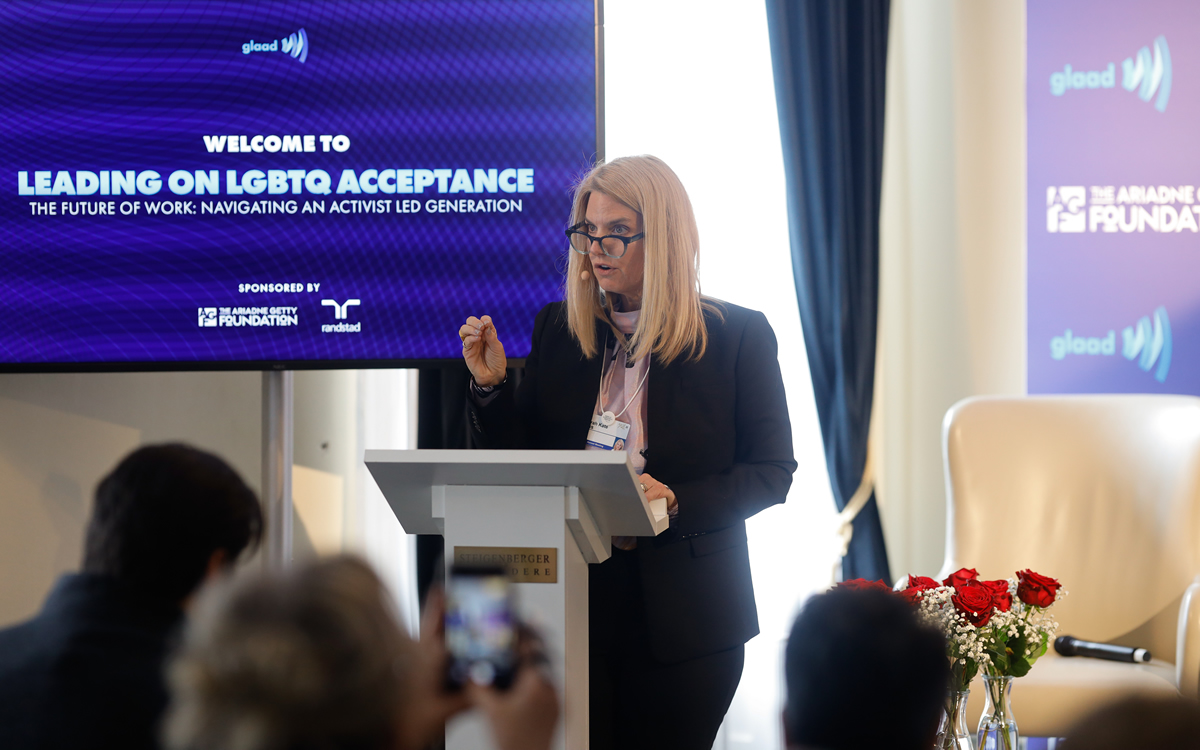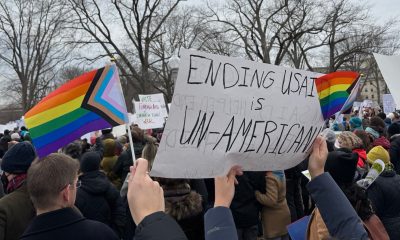Opinions
NY Times report on GLAAD riddled with bad reporting, innuendo, lies
GLAAD, Ellis should stay the course — the world needs you now more than ever

Let me say up front that no one from GLAAD asked me to write this, and I did not run its content by them or coordinate in any way. These are my independent observations based on my experience as Vice President and Chief Programs Officer under the leadership of Sarah Kate Ellis for five years. I was there for much of what is detailed in the recent New York Times story, and I feel compelled to provide a counterpoint to the imbalanced — and perhaps libelous — story put forward by the Times.
Before I get into the content of the piece, it’s incredibly relevant to point out that the writer of this piece, Emily Steel, signed an open letter last year criticizing GLAAD and more than 100 other organizations and leaders who spoke out against The New York Times’ coverage of transgender people. That alone should have disqualified her from investigating and writing this story. I won’t speculate about her motives or those of her editors, but the fact that she had taken a public position against GLAAD’s work speaks volumes.
Beyond that, the piece is riddled with bad reporting, innuendo, lies, mistruths, facts out of context, and misinformation. I know because I was there — but no one at the New York Times bothered to call any of us (and there are many) who could have instantly debunked this nonsense.
So let’s get into it — facts first.
Sarah Kate Ellis’s salary is not $1 million per year. It’s not even close. It’s easily searchable and publicly available on GLAAD’s IRS 990 forms, which are filed annually. The most recent documents indicate a salary of roughly $575,000 and a bonus of about $27,000 — a lot of money, yes, but a far cry from $1 million and very much in line with the leadership of nonprofit organizations with similar budgets.
Much has been made of GLAAD’s work at Davos, so let me offer some context there as well. The World Economic Forum meets in Davos each year and is composed of leaders from government, business and international organizations, civil society, academia, and media to tackle the world’s most pressing challenges. Until GLAAD entered the frame in 2017, LGBTQ issues were not on the agenda. Today, they are a centerpiece.
While I did not attend any of GLAAD’s trips to Davos, I was privy to the strategy, logistics, and other details related to those activations. Here’s the truth. Those trips are funded by a donor who specifically designated those funds for that purpose in order to provide GLAAD an opportunity to have a seat at the table with world leaders, Fortune 100 CEOs, and global influencers in order to make progress on criminalization of LGBTQ identities, HIV medication access, and reform in the Catholic Church. You don’t do that with events and meetings at the local Hampton Inn. If you want to have a seat at the table with world leaders, you go where they are.
GLAAD is not a direct services organization — it is an agent of culture change, and culture change is a long and expensive game. When you show up to Davos, Cannes Lions, the Emmys, Sundance, and other places of elite influence, you must show up as their equal in order to earn a place in the conversation and be trusted to co-create the change we are advocating for. And what is the change that has happened, exactly, from GLAAD’s presence in Davos?
A simple Google search will produce a laundry list of impact for the LGBTQ community from GLAAD’s work there, especially critical at a time when DEI and other inclusive programs are under attack in the corporate world. It’s also worth noting that GLAAD’s fingerprints are all over many things that never are acknowledged publicly because to do so would damage the work and the end goal.
Nonetheless, here are just a few headlines tell the tale:
Washington Blade: GLAAD, HRC Presidents Attend World Economic Forum
Associated Press: Pope Approves Same-sex Blessings For Couples
Associated Press: Pope Says Homosexuality Not A Crime
World Economic Forum: What Davos Taught Me About Supporting My Transgender Child Partnership for Global LGBTQIA+ Equality: Davos Promenade Lights Up Rainbow
New York Times: Vatican Says Transgender People Can Be Baptized and Become Godparents Here’s the bottom line.
Sarah Kate Ellis has taken the organization from literal bankruptcy to the stages at Davos, the Emmys, Cannes Lions, the Super Bowl, and countless other places to represent our community and make change. She has made GLAAD a juggernaut with a place at the table at the world’s most influential cultural moments and among the globe’s leading decision makers and culture shapers. That’s why Time magazine named her one of the 100 most influential people in the world in 2023 and why she commands the respect of the team she leads at GLAAD, the board of directors who hired her, and the leaders of the industries in which she is making change every day. On a personal level, she is one of the most honorable, visionary, judicious, and impactful leaders I have ever worked with.
It’s a shame to see the New York Times stoop to petty vindictiveness and shoddy reporting for clicks and revenge. It’s not just an attack on Sarah Kate Ellis — it’s an attack on all of us who have been a part of turning GLAAD around and making it a leading global voice for equality and acceptance. My only demand of GLAAD’s leadership would be to go even bigger, even louder, even harder, and even faster. Stay the course. The world needs you now more than ever.
(Editor’s note: Charlie Stadtlander, a spokesperson for the New York Times, disputes Stokes’s characterization of the open letter. He wrote in an email to the Blade: “The letter was not critical of GLAAD. It was signed by over 80 members of our newsroom opposed to the NewsGuild of New York engaging in or taking sides in public debates over internal editorial decisions at The Times. The letter stated: ‘Our duty is to be independent. We pursue the facts wherever they may lead. We are journalists, not activists. That line should be clear.’”)
Zeke Stokes is former Vice President and Chief Programs Officer at GLAAD and an executive producer of the award-winning documentary ‘TransMilitary.’
Commentary
America’s detransition: The far-right’s coordinated attack on climate policy and trans rights
Progress framed as ‘mistake that must be undone’

What if the far-right’s endgame isn’t just stopping progress, but erasing it altogether? From banning trans healthcare to reversing climate policies, they aren’t just resisting change — they’re trying to force the world back into an imaginary past that never existed.
Across climate policy and trans rights, the right isn’t just opposing change — it’s actively detransitioning America, unraveling progress under the guise of “common sense” and “restoring order.” But this isn’t just about ideology. It’s about power.
From pulling out of the Paris Agreement to banning gender-affirming healthcare, the right has perfected a political strategy that frames progress as a mistake that must be undone. Whether it’s climate action or trans visibility, any step toward justice is framed as dangerous, unnatural, and in need of correction.
And if we look closer, these attacks aren’t just similar — they are deeply connected. By comparing the right’s climate rollbacks and its war on trans rights, we can see a broader strategy at work: One that fuels fear, manufactures doubt, and ultimately serves the interests of those already in control.
The fight isn’t just about policy. It’s about who gets to belong in the future.
The manufactured crisis: Who profits from reversal?
To justify rolling back both trans rights and climate protections, the right leans on manufactured crises — presenting change as a dangerous social experiment gone wrong. And the most effective way to do that? Weaponizing doubt.
Take climate change. Despite overwhelming scientific consensus, climate denialists cherry-pick uncertainties — using rare instances of changing climate models to cast doubt on the entire field.
Similarly, the right has latched onto detransition stories, amplifying a handful of cases where individuals regret transitioning to suggest that all trans people will regret their identities.
By focusing on individual regret rather than systemic realities, these movements create the illusion that climate action and trans healthcare are harmful mistakes rather than necessary progress. The message is clear: We must “correct” these wrongs by detransitioning the country back to a time before this supposed damage occurred.
But who actually benefits from this rollback?
- Fossil fuel companies profit from climate skepticism, ensuring we remain dependent on dirty energy.
- Right-wing politicians fundraise off anti-trans fearmongering while avoiding economic issues that might actually improve people’s lives.
By making people believe they are “fighting back” against elites, the right obscures the actual elites profiting from this manufactured outrage.
The spectacle: Turning trans lives and climate policy into distractions
None of this would work without media spectacle. Right-wing politicians and media outlets know that the most effective way to keep people from questioning power is to keep them emotionally invested in a performance.
Take the far right’s obsession with trans youth. They flood the airwaves with panic over puberty blockers, despite the fact that gender-affirming care is exceedingly rare.
A peer-reviewed study analyzing private insurance claims found that out of more than 5 million adolescents ages 8 to 17, only 926 received puberty blockers and 1,927 received hormone therapy between 2018 and 2022.
Similarly, climate policies are attacked as elitist schemes to control the working class — painting green energy initiatives as an attack on personal freedom, just as gender-affirming care is framed as an attack on children.
By shifting the focus onto symbolic enemies — the “radical trans activist” or the “climate elitist” — the right gives people someone to hate while avoiding the real sources of economic and environmental crisis.
And this isn’t just a cultural strategy. It’s a business model.
Capitalism is in the business of creating problems, then selling solutions.
- Oil companies push carbon capture technology while continuing to pollute — ensuring the crisis is never fully solved, only managed.
- The right promotes “detransition support” while banning trans healthcare, creating a crisis where one didn’t exist.
Both strategies ensure that nothing actually changes, while making people feel like they’re participating in a fight for freedom.
It’s a distraction, and it’s working.
Nature as a battleground: The far-right’s fear of fluidity
At its core, the war on trans people and the war on climate action stem from the same fear: The fear of change.
Queer ecology tells us that nature itself is fluid, adaptive, and in constant transition. Yet, the far-right insists on rigid, binary categories:
- Man/Woman.
- Fossil Fuels/Renewables.
- Traditional/Disruptive.
In both cases, fluidity is framed as unnatural — something that must be controlled through political intervention.
- Fossil fuels are labeled “natural” energy, while renewables are framed as “forced” and “unnatural”—a rhetorical tactic explored in a 2025 study on far-right climate discourse.
- Trans identities are labeled “unnatural choices,” requiring government bans to prevent people from making “mistakes.”
But what’s truly unnatural? The attempt to freeze society in time. The climate has always changed. Gender has always been fluid. The far-right isn’t defending nature — they’re defending control.
The far-right’s detransition obsession mirrors climate rollbacks
Capitalism is not interested in actual progress — it only cares about control.
The obsession with detransition mirrors climate rollbacks in that both are framed as necessary corrections to a mistake.
- The Paris Agreement withdrawal was presented as a return to “energy independence.”
- Trans bans are framed as returning to “biological reality.”
But the goal isn’t returning to a real past. It’s about constructing a version of the past that justifies present oppression.
- Climate denial isn’t about scientific debate — it’s about maintaining corporate power, as Time reported in 2025.
- Anti-trans laws aren’t about protecting kids — they’re about enforcing gender hierarchies, according to a 2025 New York Times editorial.
Neither of these rollbacks is accidental. They are part of a deliberate strategy of control — one that tells us that progress is always temporary and can always be reversed.
Who owns the future?
If we allow the right to detransition America, we risk a world where progress is always reversible, and power remains in the hands of those who benefit from disorder and fear.
The real question isn’t whether these issues are linked — it’s why they were ever separated to begin with. The fights for climate justice and trans rights are one and the same:
- A fight against the illusion of permanence.
- A fight against manufactured crisis and controlled reversal.
- A fight for a future that actually belongs to all of us.
So what do we do?
- We must refuse to accept their manufactured doubt — trans rights and climate action are not mistakes that need fixing.
- We must reject their false nostalgia — there is no past to return to, only a future to create.
- And most importantly, we must recognize that these struggles are connected.
If we fail to see this, we risk allowing reactionary forces to shape the future. But if we understand their playbook, we can disrupt the spectacle and refuse to let them dictate what comes next.
Because this fight isn’t about going back. It’s about moving forward — and making sure no one can take that future away.
Cody Hays is a Ph.D. student at Arizona State University’s Walter Cronkite School, researching media psychology, public understanding of science, and digital misinformation, with a focus on ideological worldviews; they are a Graduate Research Fellow in the MIDaS and Views and Values Labs, executive editor of the Journal of Public Interest Communications, and a nonprofit communications strategist with over a decade of experience in combating disinformation and mobilizing action.
Opinions
Boston sanctuary designation must be backed by policy changes
A symbolic but important step for transgender protections

The city of Boston’s recent decision to give Sanctuary City status for the transgender community, while largely symbolic, is critically important. Following in the footsteps of Northampton, Worcester, Cambridge, and Pittsfield, it represents a local government’s commitment to standing with and protecting the transgender community. This is especially vital in a time when transgender individuals face increasing threats to their safety.
The number of trans people murdered in the U.S. nearly doubled between 2017 and 2021, a rise that coincided with increased anti-trans rhetoric and policies, particularly during the Trump administration.
Specifically, Black trans women have been disproportionately affected. While Black individuals make up less than one-fifth of the transgender population, they account for nearly three-quarters of known victims of anti-trans violence. Given this reality, a sanctuary designation should signal a meaningful commitment to protecting transgender residents, including addressing systemic issues within law enforcement.
Historically, both the LGBTQIA+ and Black communities have experienced harm at the hands of police. If a sanctuary designation is to be more than just a statement, it must come with actionable steps toward safety, justice, and rebuilding trust. Whether the trans community is widely aware of these votes in Boston and these other communities varies, but for those who are, such designations can provide a sense of validation, security, and hope — especially if they are backed by real policy changes.
While only a handful of cities across the U.S. have declared themselves transgender sanctuary cities, this is a movement that needs to grow. As a provider working with transgender individuals, I see firsthand the fear and uncertainty many face—simply for existing or for trying to access basic healthcare.
There have already been discussions about criminalizing providers who support transgender youth, and we have seen violent threats, including the bomb threats at Boston’s youth gender clinic a few years ago.
These designations send a strong message: that a city stands with trans individuals and the people who support them. They signal that local governments will not comply with oppressive, transphobic policies.
With Donald Trump openly advocating for a society that erases trans identities, it is crucial for cities to take a stand. Historically, civil rights movements—whether for women’s suffrage, Black rights, or LGBTQ+ rights — have only succeeded because enough people pushed back. Progress does not happen without resistance.
If more cities like Boston, step up and take these actions, it could create a powerful network of resistance that makes a real difference. Transgender individuals and their allies need to know that there are places where they will be protected, and these policies are a step toward ensuring that safety.
Predictably, the designation has prompted an outcry and recycled attacks that have been used against the queer community for decades. For example, the false narratives that LGBTQ+ people, particularly trans individuals, are pedophiles or predators or that gay men are inherently dangerous to children. The latter assumption was reinforced by scandals involving priests who abused young boys. Many people wrongly assumed that being a gay priest equated to being a child predator.
This same fear-mongering has since been weaponized against drag queens, particularly those who host story hours, and now it is being used to target transgender individuals.
While there have been isolated cases of people from any demographic committing heinous acts, it is entirely baseless to generalize an entire group based on the actions of a few.
The reality is that, according to data from the Administrative Office of the U.S. Courts, 95.5% of convicted pedophiles are men, and more than half are white. Given that transgender individuals make up about one percent of the U.S. population, most convicted pedophiles are not transgender.
Another key issue is the widespread misconception that transgender people already have equal rights. Many people assume that basic rights—like housing, employment, and healthcare—are equally accessible to all.
In reality, transgender individuals can still be legally denied housing, jobs, and medical care in many states. Queer people, in general, often face legal barriers to adoption, and while same-sex marriage was only recently legalized, it is now under political threat, with discussions about giving states the power to overturn it.
So the claim that transgender people have equal rights—especially compared to cisgender, straight white people—is not just misleading; it’s entirely false.
Will Dempsey, LICSW, is founder of Heads Held High Counseling, a social worker, drag queen and queer rights advocate. Heads Held High Counseling is a LGBTQIA+ virtual group therapy practice supporting queer and trans individuals across Massachusetts and Illinois.
Commentary
History of D.C. Pride: 1995-2007, a time of growth and inclusion
Rainbow History Project plans expansive WorldPride exhibit

In conjunction with WorldPride 2025 the Rainbow History Project is creating an exhibit on the evolution of Pride: “Pickets, Protests, and Parades: The History of Gay Pride in Washington.” In “Freedom on America’s Main Streets,” we discuss how during the 1990s the LGBTQ communities became more prominent across all areas of American life, the circumstances of moving official Pride activities to Pennsylvania Avenue, and the origin of the name “Capital Pride.”
Throughout the 1990s, LGBTQ visibility increased significantly in American society. The LGBTQ community’s presence extended beyond news coverage of AIDS activism, with members participating in various social movements. Gay Black men joined the Million Man March in 1995, carrying banners and signs proclaiming “Black by Birth, Gay by God, Proud by Choice.” Lesbians led abortion-rights rallies, LGBTQ Asians joined Lunar New Year parades, and LGBTQ Latinos marched in Fiesta DC.
Once again, financial difficulties around Pride activities led to the dissolution of the Gay and Lesbian Pride of Washington as an organization and the gay arts and culture non-profit One in Ten took over organizing Pride. One in Ten’s mission was not solely Pride planning, but rather year round activities, including an attempt to make an LGBTQ history museum. Due to the explosion of activities, the crowd sizes, and the growing concerns around feelings of exclusion brought on by the neighborhood’s identity as a primarily gay white male space, in 1995, One in Ten moved the Pride parade and festival out of Dupont Circle to Freedom Plaza on Pennsylvania Avenue.
Although the struggle for bisexual visibility had successfully added the B to the 1993 March on Washington, the push to add Trans and Queer identities to Gay Pride’s name was not yet successful; Pride was reborn as The Freedom Festival. Two years later, in 1997, the Whitman-Walker Clinic became not just a sponsor but also a co-organizer to alleviate some of the organizational and financial challenges. It was during this time that the event was officially renamed Capital Pride.
The name change sparked debate within the community. Frank Kameny, who had organized the 1965 pickets, harshly criticized the new name, arguing that it “certainly provides not an inkling of what we really mean: Pride that we are Gay.” He lamented that the name change “represents Gay shame.” However, others celebrated the inclusivity of the new name. L. A. Nash, a self-identified lesbian, wrote, “Gay is good—Gay, Lesbian, Bisexual and Transgender is far better.” Elke Martin further supported the change, stating, “A name is your identity, it gives you legitimacy and a seat at the table.” Capital Pride’s official name was now “Capital Pride Festival: A Celebration of Lesbian, Gay, Bisexual, Transgendered Community and Friends.”
In April 2000, the Millennium March on Washington highlighted divisions within the gay civil rights movement. Unlike previous grassroots marches organized by local activists, this event was orchestrated by national organizations like the Human Rights Campaign. However, its Millennium Pride Festival was by far the largest event with major headliners performing, including Garth Brooks and Pet Shop Boys. Critics argued that these events represented a corporatization of activism that sidelined political demands and local groups struggling for recognition.
In 2001, Capital Pride events were attracting 100,000 attendees. The festival was held on Pennsylvania Avenue with the U.S. Capitol in the background of the main stage. This location, often referred to as “America’s Main Street,” symbolized a significant visibility boost for the LGBTQ community. However, the Washington Post failed to cover the event beyond a simple listing in its events calendar. The outrage that ensued led Capital Pride director Robert York to state: “This is the biggest and best Pride we’ve had, and it is important to see it covered other than in the gay press.”
It wasn’t until 2007, however, that SaVanna Wanzer, a trans woman of color and Capital Pride board member, successfully established Capital Trans Pride. “The transgender community needs its own event,” Wanzer stated, “rather than just using us as entertainment. That’s all we’ve been allowed to do.” Trans Pride’s creation was a significant step toward greater inclusivity within the LGBTQ community.
Our WorldPride 2025 exhibit, “Pickets, Protests, and Parades: The History of Gay Pride in Washington,” will be installed on Freedom Plaza on May 17 to coincide with DC Trans Pride. We need your help to make it happen.




















